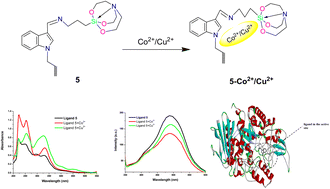A dual response UV-vis and fluorescence receptor based on acetylenic-indole conjoined silatrane for selective recognition of Co2+ and Cu2+ ions and in silico antidiabetic activity†
Abstract
This article describes the synthesis of acetylenic-indole conjoined silane (4) and silatrane (5, 6) and their structural characterization by NMR (1H and 13C) spectroscopy, TGA and ESI-QTOF mass spectrometry. The prepared compound 5 was screened for its cationic chemosensing activity, which showed selective and sensitive recognition of Co2+ and Cu2+ ions with considerable change in the intensities of absorption and emission maxima. Furthermore, the binding constant, Stern–Volmer constant and limit of detection were calculated by plotting the BH-plot, Stern–Volmer plot and linear calibration curve, respectively. The LOD values obtained from fluorescence spectroscopy for Co2+ and Cu2+ ions were 0.3812 × 10−6 M and 0.4130 × 10−6 M, respectively, which are below the WHO allowable limits of Co2+ (1.70 μM) and Cu2+ (20 μM) ions in drinking water, suggesting that the silatrane receptor 5 may be used for biological and industrial purposes. Moreover, the molecular docking studies provide useful information about the interaction of compound 5 with the α-glucosidase enzyme (PDB ID: 3A4A).



 Please wait while we load your content...
Please wait while we load your content...